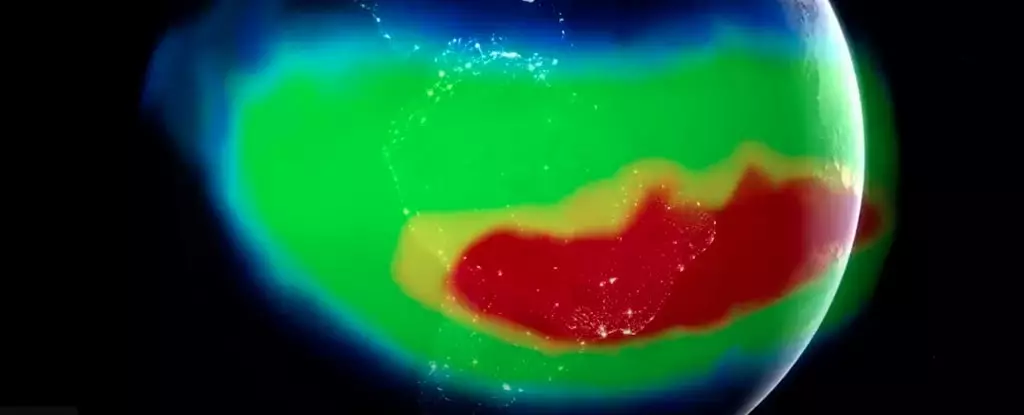Earth’s magnetic field is essential for life as we know it, shielding us from harmful solar radiation and cosmic rays. However, NASA has identified a peculiar anomaly hovering above the planet’s surface: the South Atlantic Anomaly (SAA). Spanning a vast area from South America to southwest Africa, this region of diminished magnetic intensity has captivated the attention of scientists for years and presents significant challenges, particularly for orbiting spacecraft. While the phenomenon may not have immediate consequences for life on Earth, its implications for space exploration and technological reliability raise essential questions.
The SAA can be visualized as a substantial dent in Earth’s protective magnetosphere, affecting satellites, the International Space Station, and other spacecraft operating within low-Earth orbit. These craft traverse the anomaly, where the weakened magnetic field allows for an influx of high-energy particles from the Sun. During these encounters, sensitive onboard technology runs the risk of malfunctioning or suffering permanent damage due to electrical surges caused by proton collisions. Consequently, satellite operators frequently engage in precautionary measures, shutting down essential systems as these spacecraft prepare to negotiate the vulnerability presented by the anomaly.
The Science Behind the Anomaly
The science behind the SAA is intricate and fascinating. The primary force shaping Earth’s magnetic field emerges from a swirling ocean of molten iron in the outer core, located thousands of kilometers beneath the Earth’s crust. This movement generates electrical currents, resulting in the Earth’s magnetic field. However, the distribution of these currents is not uniform, leading to anomalies like the SAA’s pronounced weakness. Terry Sabaka, a geophysicist at NASA’s Goddard Space Flight Center, highlights that the anomaly’s magnetic field strength is compromised, partly due to the African Large Low Shear Velocity Province — a dense rock mass located deep beneath the African continent. This geological feature disrupts the typical generation of magnetic fields, contributing to the anomaly’s vulnerability.
Moreover, NASA researchers have investigated the complex interplay between various magnetic sources and the anomalies created by natural occurrences deep within the Earth. As new studies emerge, our understanding expands, revealing an intricate tapestry of geomagnetic phenomena deeply rooted in our planet’s geology.
The Ongoing Evolution of the SAA
Recent studies indicate that the South Atlantic Anomaly is far from static; it exhibits a slow yet deliberate movement across the globe. A 2016 investigation led by NASA’s Ashley Greeley unraveled the mystery of this drift, confirmed by data collected from CubeSats in subsequent years. The truly remarkable revelation, however, lies in the SAA’s potential fragmentation. Research from 2020 suggests that this anomaly may be splitting into two distinct centers of magnetic intensity, each characterized by its unique minima within the greater SAA. This division raises critical questions about its long-term impact on Earth’s magnetic field.
Our understanding of the SAA’s behavior is crucial, not only to ensure the safety and efficacy of space missions that traverse its bounds but also to prepare for potential future shifts in the Earth’s magnetic field. This anomaly may be a harbinger of geological changes grounded in deep-time history, affecting us in unpredictable ways. The research indicates the SAA is not merely a recent aberration but rather a recurrent feature of Earth’s magnetic history, potentially dating back millions of years. This insight provides a speculative context in which scientists can consider the SAA’s future impact on global geomagnetism and possible correlations with past magnetic reversals.
Future Exploitation and Observational Priorities
As we continue to peel back the layers of the SAA’s mystery, it becomes increasingly apparent that NASA’s salvation may lie in sustained observation and research initiatives. The interconnectedness of the anomaly with other geophysical phenomena demands a proactive approach to monitoring. As Sabaka observed, although the SAA is characterized by a slow-moving progression, it continues to evolve in complex ways. This underscores the necessity for ongoing observational missions to gather critical data and monitor the health of both the anomaly and the satellites that traverse its depths.
Emphasizing the importance of this magnetic oddity, scientists must address the potential challenges posed by the SAA. As technology advances and our reliance on satellites increases, safeguarding critical systems against anomalies like the SAA will remain paramount. Future space missions may also serve not only to gather data about the SAA but also to enhance our understanding of the Earth’s magnetic system as a whole, potentially leading to groundbreaking discoveries that illuminate our planet’s past, present, and future.
Through its relentless pursuit of knowledge, NASA stands at the forefront of unearthing the secrets of the South Atlantic Anomaly. As the investigation unfolds, there are profound implications that extend beyond the realm of mere scientific curiosity; understanding the SAA may hold the key to a deeper comprehension of Earth’s dynamic geological processes and their impact on life and technology. The journey toward unraveling this magnetic enigma is not solely about safeguarding our spacecraft—it’s a tantalizing dive into the complexities of our planet and the universe at large.

